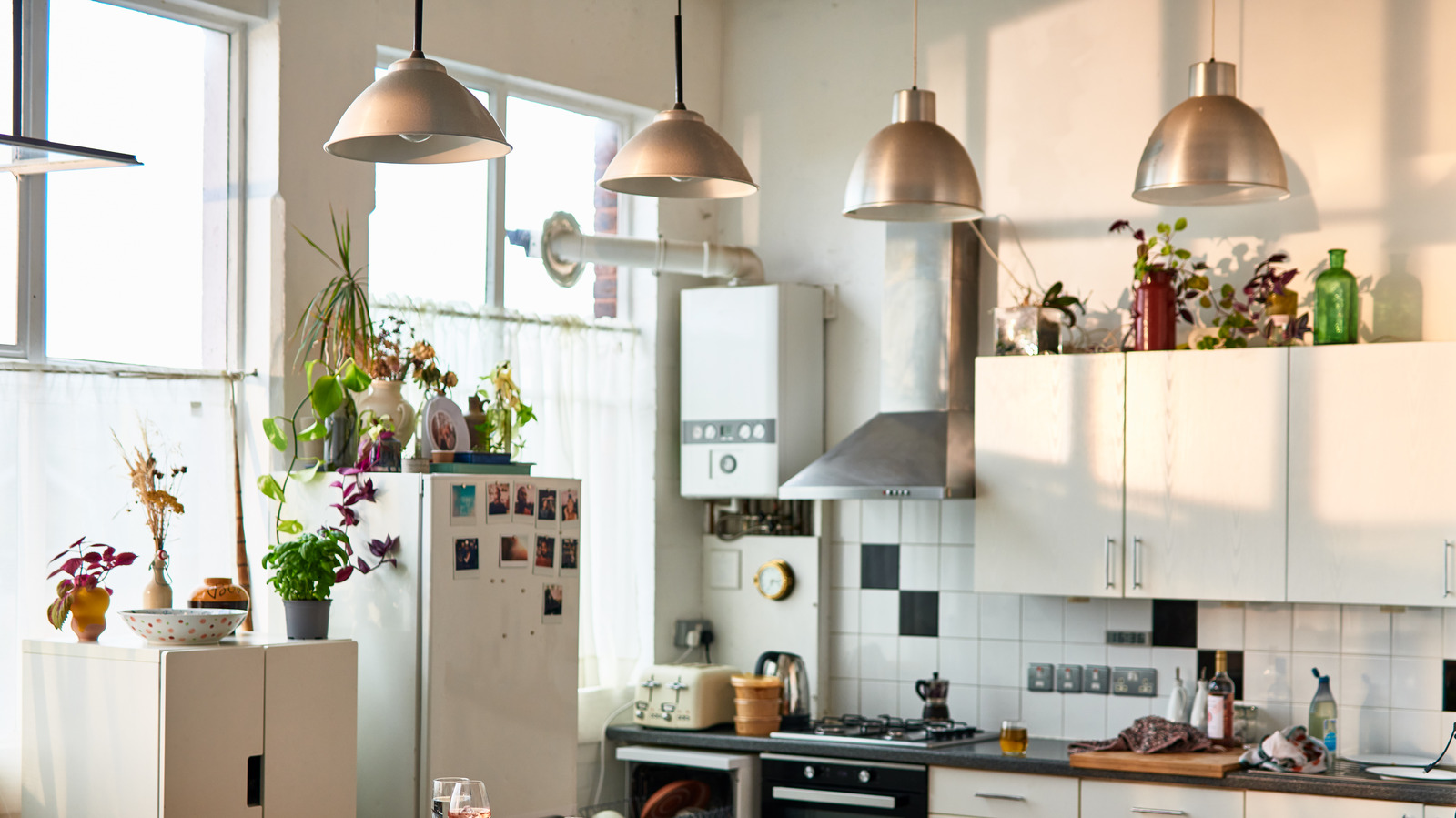Out of all the rooms in your home, the kitchen is the most reliant on a great design. Along with the aesthetic components, you also need this space to be functional and comfortable — but one area people often underestimate is their kitchen’s lighting plan.
Even with beautiful cabinetry or the perfect worktops in place, a bad lighting plan can negatively impact the whole space. In fact, they can instantly make the room look dated, drab, and out-of-style. In an effort to avoid this conundrum, we talked to two professional interior designers who shared their top picks for which lighting faux pas to avoid if you want a stylish kitchen – Brittny Button of Button Atelier and Melissa Roberts of Melissa Roberts Interiors — as well as why great lighting is so important in the first place.
“Kitchen lighting can effortlessly lend warmth, personality, and texture where it’s not only about functionality, but an intentional design statement,” says Roberts. Let’s get into the details.
Dropped ceilings with built-in lighting
According to designer Brittny Button, one of the first things she looks out for in a home is a dropped ceiling with built-in lighting. This look, she says, screams 1960s and 1970s. And not in a chic, retro way.
“If I see this in a renovation or client’s home, it’s the first thing to be torn out,” she explains. “It encloses the space in a bad way and the lighting is similar to a hospital setting. Not good.”
Instead of a dropped ceiling, Button says she prefers it to be coffered. This classic style features a grid pattern of recessed paneling set in geometric shapes like rectangles, squares, or hexagons, and the texture can enhance the ceiling height and add more visual interest. This is particularly true when the lighting design is then incorporated with the coffered effect. “Include some pot lights so the eye isn’t distracted by any light fixtures,” Button suggests.
Sconces
The vast majority of designers will tell you that layering various types of lighting throughout your kitchen is important. However, even with this design rule in mind, there are some fixtures to skip. If you’re trying to avoid a dated look, Brittny Button says decorative wall sconces are unfortunately a no go. This comes down to both their aesthetic, and the glow they cast.
“Avoid sconces or lighting that projects upwards rather than downwards,” she says. “These are more appropriate for a bathroom or bedroom setting instead where soft ambient light is desired.”
You could even use these in a dining room, but wall sconces really are not a great fit for the kitchen. Instead, Button suggests using pendant lights. These are both much more functional and can do more aesthetically for your space. “Plus, they offer muted directional light that layers well within the landscape of a kitchen,” she adds.
Builder-grade overhead fixtures
If you have moved into a home that already has one mounted overhead light fixture secured and hanging in the kitchen, chances are high that it is builder-grade. This could mean you are dealing with anything from a bulky fluorescent box light to the dreaded “boob” light. The metallic fixtures feature opaque white glass, and are a ubiquitous builder-grade option for kitchens, bathrooms, and entryways.
But whatever fixture your builder installed, Melissa Roberts says it is likely a major kitchen lighting faux pas and best to replace. “For an updated look, opt for a series of flush-mounts or even semi-flush mount fixtures that give off a softer, diffused glow,” she explains. “Bring in textures including marble, antiqued brass, or even leather.” This, says Roberts, is a great way to make your lighting feel more like an intentional design accent that completes the space — not a cookie-cutter essential that is all function and no style.
Overly soft task lighting
Task lighting is a must in most kitchens. This is the lighting featured above your work station, and it is usually fixed to the cabinetry hanging above. But, as Brittny Button points out, it has to be done well to be useful. Otherwise, you are facing a frustration rather than a function. This can happen if the lighting you add is too dark or dim, which can also make your whole kitchen look dreary.
Luckily, this does not mean you need to have glaring fluorescent task lighting, either. Instead, install a happy medium. “Always ensure that it is dimmable,” she explains. “That way, there’s a versatility of settings and therefore use.”
Button also suggests opting for task lighting that has a higher lumen, which is the measurement of light emitted by the bulb. This is best for workspace tasks like chopping and food prep. “Anything too soft is underwhelming and frustrating when you’re trying to cook or bake,” says Button.
Uplighting
Just as the downlight of sconces can create an unpleasant, dated feel to your kitchen, so can uplighting. Along with being generally out of style at the moment, uplights are also unlikely to be particularly useful in a kitchen. Instead, they are best used in spaces where you’re trying to create ambiance without much functionality.
As another risk, uplighting can often clash with the glow of other more necessary lights in the kitchen. This is a problem Melissa Roberts says she often sees when people mix too many types of bulbs. “Too many contrasting color temperatures, such as cooler LEDs with more yellow tones, [can] cause inconsistent lighting overall,” she says.
To keep things simple, it is best to work with a combination of overhead lighting, task lighting, and pendant light fixtures. These are more easily controllable, but also allow for a layered lighting plan that makes sense in a multi-purpose space like the kitchen. Save the uplights and sconces for rooms that call for a softer, scattered glow.
Badly scaled island lighting
Picking the right light fixtures for your kitchen island is truly an art in and of itself. There are so many styles for this particular spot, and as Melissa Roberts notes, it is also a chance to make a design statement and really tie your whole space together. On the downside, however, this also means that if it is done incorrectly, it can be the thing that really dates the room.
“Opt for a set of well-scaled flush-mounts or even a larger-scaled linear fixture to visually anchor the space,” Roberts suggests, noting the particular importance of scale. “Avoid fixtures that are too small or too large, they can appear awkward and overly cluttered and overwhelming.”
Along with scale, you will also want to be sure the lighting is hung at the right height. This applies to any pendant lighting you use, whether it is over your island or your dining table. These two elements are the best way to make your kitchen feel balanced and cohesive, Roberts notes.
Too many vintage accents
Vintage elements have always had their place in design, and we have even seen whole eras make major comeback and transform into something more current. Think, for example, of the rise of mid-century modernism.
But in these cases, it is never about throwing your home fully into another era (unless you really, really want to commit to the bit). The balance of old and new is key, and this applies to vintage trends in the kitchen, too. “Opt for modernized organic options that reference a vintage feeling, yet feel current,” says Brittny Button. “For instance, pendants with both metal and glass elements offer a mix of historical and organic design.”
Melissa Roberts agrees, and says a good rule of thumb is to echo the same vintage elements throughout your kitchen, rather than just tossing a bunch of fussy pieces together and hoping it looks cohesive. So, if you have a beautiful vintage pendant light over your table, add pieces that echo its look in color, style, or material.
“This can include easy fixes like hardware or countertop decor instead of a complete overhaul to keep the space feeling intentional,” says Roberts. “I love mixing modern elements with vintage pieces!”
Bulky puck lights
Cabinetry lighting is a surefire way to make a kitchen look refined and finished, but Melissa Roberts warn that there’s one major exception. Bulky puck lights are a guaranteed way to do more harm than good, especially if your goal is a streamlined and stylish space that feels current. Even if you manage to hide the lights themselves, the glow they cast can be spotty and strange, and disrupt the flow of your space.
“I recommend sticking to LED strip lighting with the color temperature ranging from 3000-3500k to give the kitchen a warmer glow,” she says. “If properly installed behind the cabinet frame, the strips are completely hidden from plain sight.”
Roberts notes that the strips are more malleable, which allows them to blend into existing cabinetry — unlike puck lights. “They don’t provide the same seamless look and can be harder to hide under cabinets,” she says. “[They] look that much more dated in comparison.”
Fluorescent tube lighting
If you want to make a room feel dated, drab, or clinical, fluorescent tube lighting will get the job done. It doesn’t matter if it is used overhead or as task lighting. Fluorescent lights are just rarely the vibe you want for a warm and welcoming kitchen lighting plan — or anywhere in your home, for that matter.
While homes have been using fluorescent lighting for decades, these days, it is rarely a careful design decision. Instead, you are likely to still come across fluorescent tube lighting in homes that have kept their builder-grade fixtures in place. While it is, of course, functional, it’s really not aesthetically pleasing, so if you have it in your kitchen and can’t quite pinpoint what’s making the room feel dated, this is a great starting point.
Opt instead for LED lighting where possible, and pendant lights or flush-mount options if you’re replacing an overhead pick. The improvement will likely be instant.
One lighting plan for the whole day
Beautiful light fixtures will only get you so far. If your whole kitchen glows at the same level no matter the time of day, it is likely to have moments where things feel wrong and possibly outdated.
Instead, Brittny Button suggests creating what she calls a “script of lights” for the different touch points of the day. “For me, in the morning before school, I like there to be a feeling of joyfulness for the kids!” says Button. “I mix the ambient pendant lighting with the high lumens under cabinet lights, reflected off of the backsplash and pot lights over the sink.”
But when she’s not looking for a joyful burst to start the day, Button prefers to let the natural light stream through whenever possibly. Then, at night, the lights come back on. “In the evening, I love the drama and dim the lights to have a candlelight feel for dinnertime with the family,” she says.
Too many recessed lights
Recessed lighting is understandably popular in most home kitchens because it is a great way to keep the space bright and functional throughout the day. But even so, recessed lighting shouldn’t be your primarily light source. Instead, Melissa Roberts says it’s best to tie in ambient, task, and accent lighting so that the space feels thoughtful while also lending itself to productivity.
“Having too many recessed lights visually flatten a kitchen, leaving it without a strong focal point,” she says. Roberts also notes that a nice mix of other light sources should create a more warming glow.
This is especially true when your kitchen lighting is used in conjunction with independent dimmer switches that can manage individual zones. Along with your overhead recessed lighting, Roberts suggests adding strategically placed pendants over your island and dining area, as well as under-cabinet LED strips. When used all together, this combination is guaranteed to keep the whole space intentional and fresh.
Perfectly matched light fixtures
At some point, people started to think the best way to create a cohesive design plan was to make sure everything matched. In the kitchen, this often includes upper and lower cabinetry, worktops, and yes, light fixtures. But with time, the design world has transitioned to mixing and matching these elements in a way that feels warmer and more inviting.
This means now that too many perfectly matched light fixtures can have the undesirable effect of making a kitchen feel outdated. Instead of matching everything, consider changing up the material, shape, or scale to help your kitchen feel more visually interesting.
Instead of trying to pair everything perfectly, tie the pieces together with common elements that complement each other. You can even consider letting your overhead light fixtures pop as true statement pieces, letting them stand out from the rest of the space in a way that’s truly eye-catching.
Ignoring dark corners
If you haven’t designed your own kitchen from the ground up, then more than a few of the words of advice mentioned above are likely out of your control. Recessed lightning, for example, is not something you can just add one day, and it might be difficult to swap out your island light pendants. This is especially true if you live in a rental.
But even if your kitchen is lacking in preexisting wiring or outlets, there are still plenty of ways you can update your kitchen’s lighting plan. Often, this comes down to ensuring there are light sources in all the key areas so that no corners are left too dark and drab.
This can best be done with everything from self-adhesive strip lights and discrete puck lighting to rechargeable table lamps. However you add more light to your room, you’re likely to discover a warm, stylish effect in the end.





